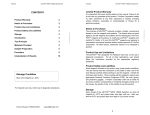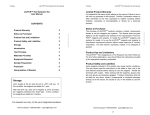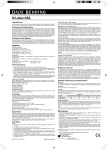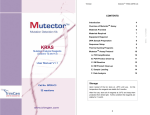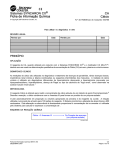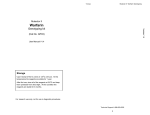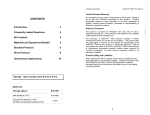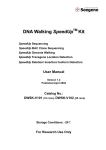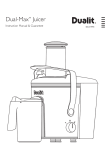Download Manual - Trimgen
Transcript
eQ-PCRTM MYD88 L265P Detection Kit TrimGen CONTENTS 2 Notice to Purchaser 2 Product Use and Limitations 2 Product Safety and Liabilities 2 Storage 2 Introduction 3 Test Principle 3 Materials Provided 4 Sample Preparation 5 Procedure 6 Interpretation of Results 10 Storage Condition Store all of reagents at –20oC. For research use only, not for use in diagnostic procedures. Technical Support:1-888-825-6005 [email protected] EP14-MYD88-052015 V1.1 Product Warranty eQ-PCRTM MYD88 L265P Detection Kit TrimGen Limited Product Warranty It is imperative that users strictly adhere to this manual. Failure to do so will void our guarantee of this product. TrimGen Corporation makes no other warranties of any kind, expressed or implied, including without limitation, warranties of merchantability or fitness for a particular purpose. The purchase of eQ-PCRTM products includes a limited, nonexclusive license to use the reagents and systems. This license does not grant rights to use the reagents and systems for the reproduction of the eQPCRTM reagents and systems, to modify the eQ-PCRTM reagents and systems for resale, or to use the eQ-PCRTM reagents and systems to manufacture commercial products without written approval of TrimGen Corporation. No other license, expressed, implied, or by estoppels is granted. Product Use and Limitations The eQ-PCRTM Kit is designed "For Research Use Only, not for use in diagnostic procedures.” For all of other applications, user should follow the instructions provided by the appropriate regulatory authorities. Product Safety and Liabilities Some reagents included in this product may cause harmful conditions. The user should read the instructions on the bottle or tube, and in the User Manual carefully before starting to use the reagents. Handle the chemicals with caution. When working with the reagents, always wear appropriate Personal Protective Equipment (PPE), lab coat, gloves, and protective goggles. TrimGen Corporation shall not be liable for any direct, indirect, consequential or incidental damages arising out of the misuse, the results of use, or the inability to use this product. Storage Upon receipt of the eQ-PCRTM MYD88 L265P Detection kit, store all reagents at –20oC and protect them from light until use. After use, store at 2-8oC and protect them from light for up to three weeks. 2 EP14-MYD88-052015 V1.1 Notice to Purchaser eQ-PCRTM MYD88 L265P Detection Kit TrimGen Introduction The eQ-PCRTM MYD88 L265P Detection Kit is designed to detect the MYD88 L265P mutation presented in DNA samples. The mutation is detected by TrimGen’s proprietary eQ-PCR (enhanced QuantitativePCR) technology (US patent pending) and the assay is conducted by real-time PCR system. TrimGen’s eQ-PCR™ MYD88 L265P Detection Kit provides an accurate, sensitive and rapid assay to detect the MYD88 L265P mutation. 3 EP14-MYD88-052015 V1.1 The myeloid differentiation primary response 88 gene (MYD88) encodes a cytosolic adapter protein, which acts as an essential signal transducer in the IL-1, IL-18 and Toll-like receptor signaling pathways and plays a central role in the innate and adaptive immune response. The MYD88 L265P mutation is a gain-of-function driver mutation that has been found in more than 90% of Waldenström macroglobulinemia (WM) / lymphoplasmacytic lymphoma (LPL) patients. eQ-PCRTM MYD88 L265P Detection Kit TrimGen Materials Provided: The eQ-PCRTM MYD88 L265P Detection Kit contains pre-packaged reagents for 32 reactions. Cap Color Quantity PCR Mix Q Purple 350 μl MYD88-TP White 35 μl MYD88-WT CTL Yellow 20 μl MYD88-Mut CTL Orange 20 μl Clear 500 μl NF Water *Note: The MYD88-TP is light sensitive. Keep this reagent protected from direct light. PCR Mix Q (Purple cap) Pre-mixed reagents for DNA amplification MYD88-TP (White cap) Mix of primers and probes to detect MYD88 L265P mutation MYD88-WT CTL (Yellow cap) Control DNA samples for MYD88 wild type MYD88-Mut CTL (Orange cap) Control DNA samples for MYD88 L265P mutant identification NF Water (Clear cap) Nuclease-free water for the blank control 4 EP14-MYD88-052015 V1.1 Tube Label eQ-PCRTM MYD88 L265P Detection Kit TrimGen Sample Preparation: TrimGen provides high efficiency DNA extraction kits for the following samples: Paraffin-embedded (FFPE) tissues Fresh or frozen tissues Fine Needle Aspiration tissues Cells Cat No. WaxFree DNA WF-50 (50 extractions) WF-100 (100 extractions) Blood samples Any commercially available DNA extraction kit is acceptable. Adjustment of DNA concentration: When using a column or bead DNA extraction method, adjust the DNA concentration to 10-80 ng/l. When using TrimGen’s DNA preparation kit, follow the kit protocol to perform the PCR amplification. 5 EP14-MYD88-052015 V1.1 Kit Name eQ-PCRTM MYD88 L265P Detection Kit TrimGen Assay Procedure: A. Reaction Preparation Thaw all reagents to 2oC to 8oC when ready to use. Keep all reagents at 2oC to 8oC during preparations. A.1. Collect PCR tubes and label the tubes as follows: EP14-MYD88-052015 V1.1 Blank control MYD88-WT CTL (wild type control) MYD88-Mut CTL (mutant control) Sample #1 Sample #2 Sample #3 Sample #4 Sample #5 A.2. Prepare Master Mix for the total number of samples to be tested using the table below: Reagents PCR Mix Q Formulation 10 l x ( Volume + 3*) x 1.1** sample# MYD88-TP 1.0 l x ( NF water 7 l x ( + 3*) x 1.1** sample# + 3*) x 1.1** sample# Total Volume * The “3” are the blank, positive and negative controls. ** 1.1 is the recommended volume correction factor for pipetting error during aliquoting. 6 eQ-PCRTM MYD88 L265P Detection Kit TrimGen A.3. Aliquot 18 µl of Master Mix to each tube. A.4. Add 2 µl of NF Water into the blank control tube. A.5. Add 2 µl of MYD88-WT CTL into the wild type control tube. A.6. Add 2 µl of MYD88-Mut CTL into the mutant control tube. A.7. Add 2 µl of sample DNA (10-50 ng/µl) into the sample tube. A.9. Spin the tubes. A.10. Load the tube onto the Real-Time PCR System. B. Run the PCR The detector selection: Allele Detector MYD88 Mut FAM MYD88 WT VIC The thermal cycling conditions: Stage 1 1 Cycle 95oC, 15 min Stage 2 40 Cycles 95oC, 15 sec 60 oC, 30 sec 72 oC, 30 sec The following procedure is an example of using Applied Biosystems Model 7500 Real-Time PCR System for BRAF mutation detection. When using other real-time PCR systems, users should set up their instrument based on instructions from the manufacturer. B.1. Click the 7500 System Software icon on the computer screen. B.2. Click “Create New Document” in the dialog box. 7 EP14-MYD88-052015 V1.1 A.8. Cap the tubes and mix the samples well by tapping the tubes. eQ-PCRTM MYD88 L265P Detection Kit TrimGen B.3. In the New Document Wizard Dialog box, Select “Standard Curve (Absolute Quantification)” and give a plate name. Click “Next”. EP14-MYD88-052015 V1.1 B.4. In the “Select Detectors” Window, click “New Detectors”. In the pop-up window, fill in the information following the table below. Click “OK”. (Note: Refer to the ABI 7500 User Manual for instructions on creating a new detector table.) Detector Name Reporter Quencher MYD88 Mut FAM None MYD88 WT VIC None 8 eQ-PCRTM MYD88 L265P Detection Kit TrimGen B.5. In the same window, highlight the detectors created and then click “ADD” in order to add MYD88 Mut and WT into the “Detectors in Document”. In the “Passive Reference” box, select “ROX”. Click “Next”. EP14-MYD88-052015 V1.1 B.6. At the “Set up Sample Plate” window, specify the “Detector” and “Task” (from top window options) for each selected well (from lower window). For example, assign “MYD88 Mut” and “MYD88 WT” to the sample wells. Click “Finish” to create the plate document. 9 eQ-PCRTM MYD88 L265P Detection Kit TrimGen B.7. At the next screen, click the “Instrument” tab. B.8. Set up the thermal cycle conditions, under the “Thermal Profile” tab, as follows: EP14-MYD88-052015 V1.1 Stage 1 – 95oC, 15 min Stage 2 – 95oC, 15 sec 60oC, 30 sec 72oC, 30 sec B.9. Enter “25” in the “Sample Volume (L)” box. B.10. Set “Data Collection” at “Stage 2, step 3 (720C for 0:35)“. B.11. Click “Start” to run the PCR amplification. B.12. Click on “Save and Continue”. B.13. Save file under new file name. C. Interpretation of Results C.1. After the PCR program has finished, locate the data file and open it. C.2. Click “Results” tab. Go to the “Amplification Plot”. 10 eQ-PCRTM MYD88 L265P Detection Kit TrimGen C.3. Highlight the wells to be analyzed at the bottom of the screen. C.4. Go to the top of the menu bar and select “Well Inspector”. At the bottom of the menu, select “none” in the “Passive Reference” box. Click the “Close” button. EP14-MYD88-052015 V1.1 C.5. Then, select “Delta Rn vs Cycle” in the Data drop-down list. C.6. In the Detector drop-down list, select a detector, either wild type (WT), mutant (Mut) or All. C.7. Under Analysis Settings, select “Manual Ct” and “Manual Baseline”. C.8. Click on the “Analyze” button. 11 eQ-PCRTM MYD88 L265P Detection Kit TrimGen C.9. In the next window, double click the Y axis to open the “Graph Setting” dialog box and select “Liner”, then click “OK”. EP14-MYD88-052015 V1.1 C.10. Click on each sample position (from the lower window) to highlight the sample that you would like to analyze. Each sample must be analyzed on one of the two “Detector” windows (MYD88 Mut or MYD88 WT). Only one allele type, Wild type (WT) or Mut (L265P) can be analyzed per “Detector” window. Whether the individual carries a mutant allele is determined by the end-point fluorescence value of the amplification curve. For example, if the sample does carry an MYD88 mutation, its endpoint fluorescence value should be greater than that of the MYD88-WT CTL or your wild type control sample. C.11. Select ”Mut” in the “Detector” window C.12. Make sure one has highlighted the wells (samples #1-#6) to be analyzed at the bottom of the screen 12 eQ-PCRTM MYD88 L265P Detection Kit TrimGen 1 2 3 5 6 Sample #1: Kit mutation control (showing exponential curve) Samples #2-4: > 5% mutation (showing exponential curve) Sample #5: Kit wild type control (no amplification) Sample #6: Wild type patient sample control (no amplification) C.13. For samples containing less than 5% mutation, such as sample #3 (in Fig. K1) and samples #1 & #2 (in Fig. K2), it is recommended to repeat the test to double confirm the low level mutation. Fig. K1 1 2 3 4 Sample #1: Kit mutation control (showing exponential curve) Sample #2: About 5% mutation (showing exponential curve) Sample #3: < 5% mutation (showing exponential curve) Sample #4: Wild type kit control (no amplification) 13 EP14-MYD88-052015 V1.1 4 eQ-PCRTM MYD88 L265P Detection Kit TrimGen Fig. K2 1 2 3 EP14-MYD88-052015 V1.1 Sample #1: Sample #2: Sample #3: < 5% mutation (showing exponential curve) < 5% mutation (showing exponential curve) Wild type patient sample control (no amplification) 14 eQ-PCRTM MYD88 L265P Detection Kit TrimGen C.14. All test samples should contain the wild type allele. To view the wild type allele, select ”WT” in the “Detector” window EP14-MYD88-052015 V1.1 1 2 3 4 5 6 Sample #1: Kit wild type control (showing exponential curve) Samples #2-#5: Containing wild type allele (showing exponential curve) Sample #6: Kit mutation control (no amplification) 15 eQ-PCRTM MYD88 L265P Detection Kit TrimGen NOTES: EP14-MYD88-052015 V1.1 16
















